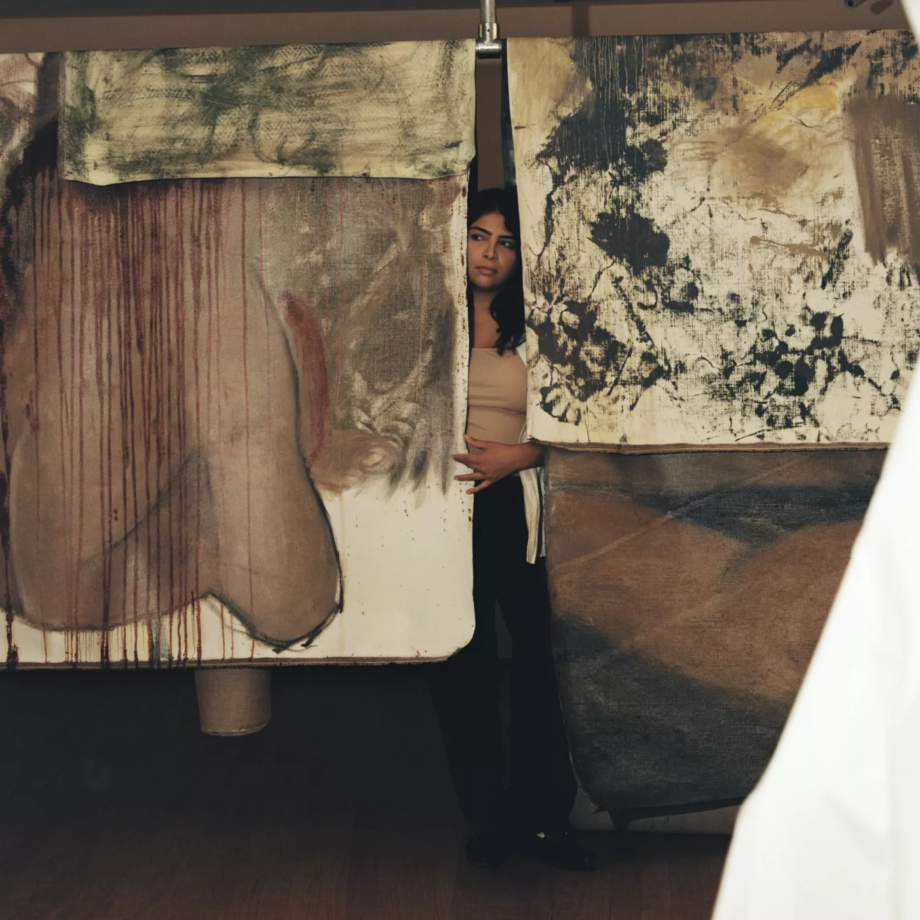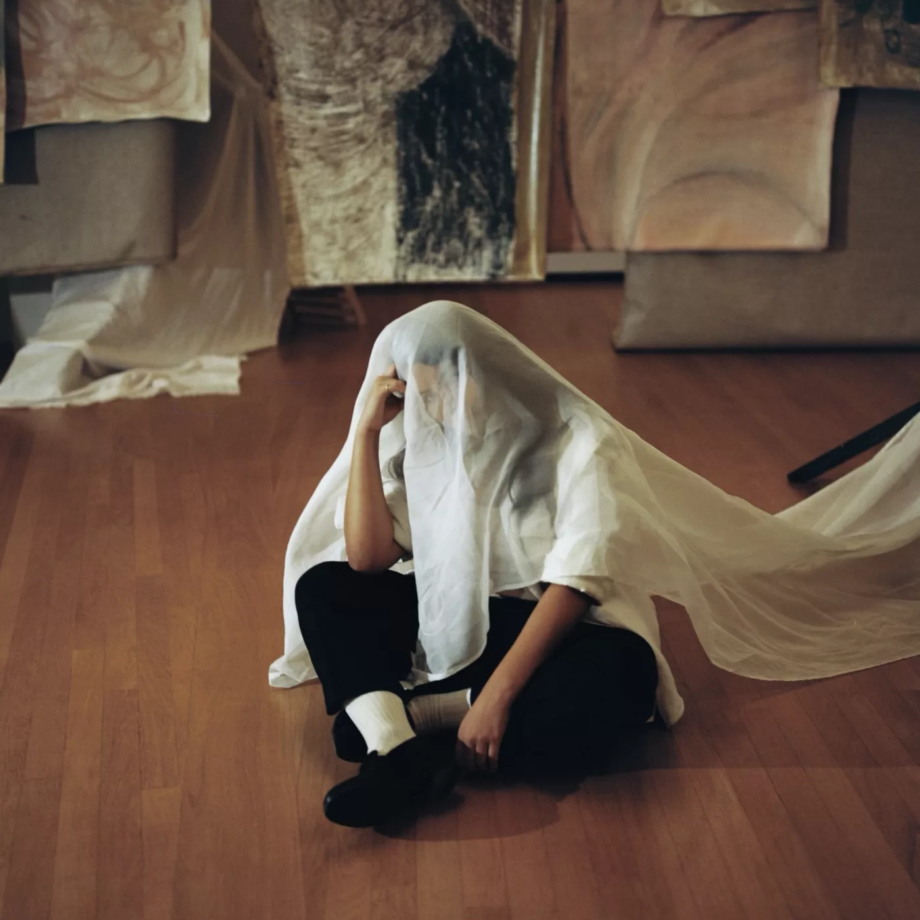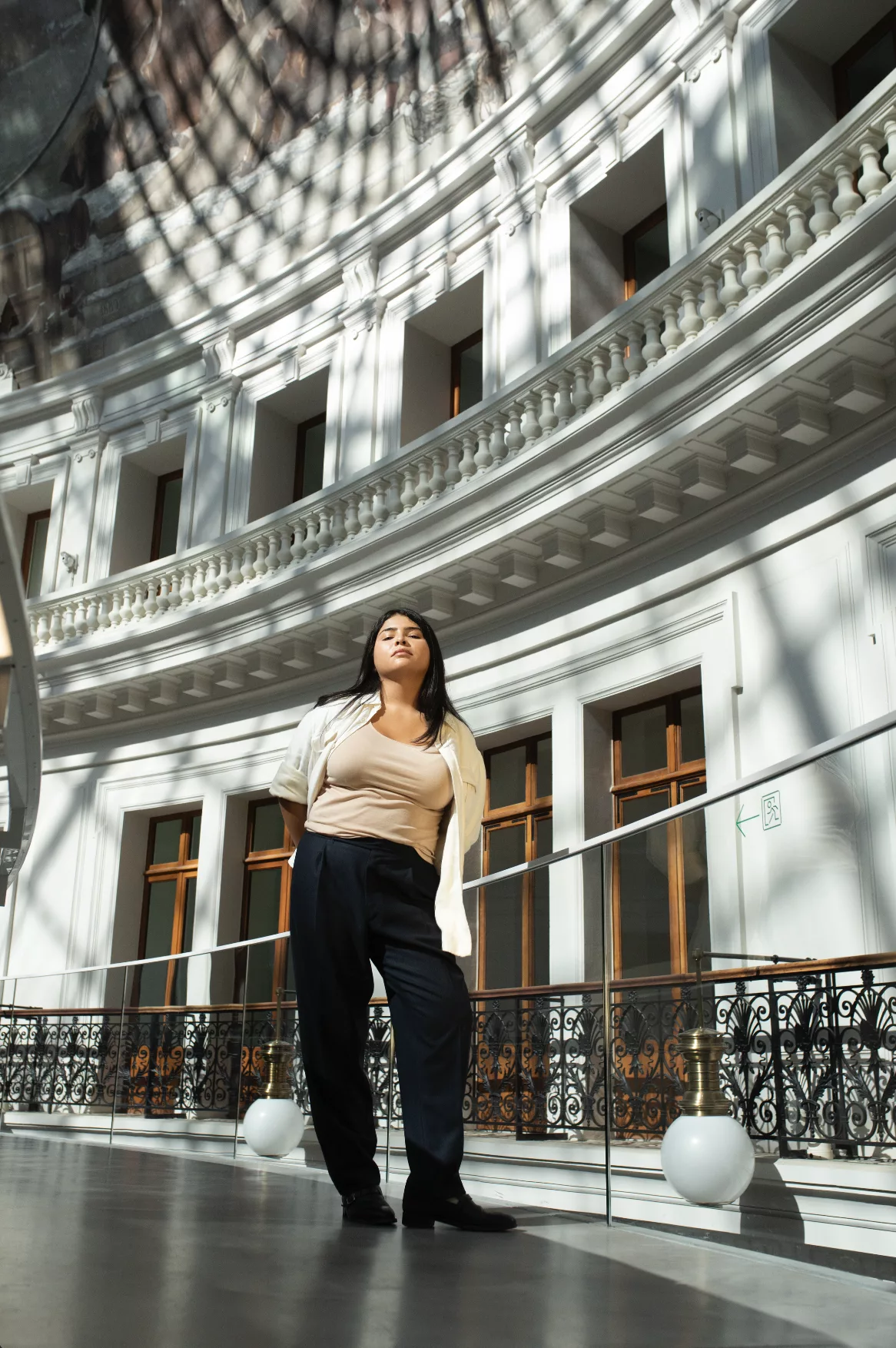Tune in to Eloise Hendy’s conversation with Ser Serpas about balancing the roles of art-world scammer and “fun American girl”

Halfway through my conversation with Ser Serpas, her phone rings. “That might be a delivery of furniture that’s supposed to happen in like three hours”, she says. “I got this weird daybed. Can I show you?” She holds her phone up to her computer camera. A strange looking object appears—one that bears little resemblance to what most people would call a ‘day bed’. “It’s two antique gymnasium mats and a barbell thing”, Serpas says with glee. She has only recently returned to New York, after spending the last few years bouncing around Europe—from Zurich and Geneva to Tbilisi and most recently Paris—and the procurement of this eccentric piece of furniture feels like a fortuitous homecoming omen. “New York is a wonderful place after all”, she cackles. “I know there’s really ancient sweat on those gym mats, but it’s gonna make the perfect day bed.”
The timing of this call feels fortuitous too, because for the last half hour we have been talking about eccentric pieces of furniture, strange assemblages and stumbling across cool stuff. Looking at Serpas’s “weird daybed”, I can’t help sharing her glee, because it looks as if it could be one of her sculptures.
Still not yet 30, Serpas has received a decent dollop of acclaim for her sculptural practice and her use of found materials. To put it simply, she has built up a continent-spanning reputation as a rubbish artist—a connoisseur of trash. For successive exhibitions in Europe and the United States, she has created strange and precarious works assembled from urban detritus: an Ikea Kallax unit impossibly balanced in the seat of a reclining pleather chair; a mattress tangled between shopping trolleys like a caged creature attempting escape; another mattress squeezing through a hole in a wooden board. Her arrangements are surreal and corporeal; they are often described in bodily terms like ‘fleshy’ and ‘protruding’. They are also site specific. For each show, Serpas goes on the hunt for objects in the gallery’s immediate vicinity. “Parisian trash is sturdy”, she said in a recent interview, while in Switzerland litter is scarce, she tells me: “You drop a piece of gum in a spot and you can be pretty sure, that night it’ll probably be gone.”
“I’m building a palette every time I go to a new city”, she says of her urban foraging. “I like to source things that are able to play with each other nicely—things that have a puzzle-like quality to them.” Once the parts are gathered, Serpas assembles her sculptures within the gallery. Each trashy composition contains traces of the city outside, and of her physical exertion. “It’s really a bit of improv”, she says of this way of working. “Or perhaps a better word is choreography? I want you to see me as a dancer sometimes”, she laughs. In any case, the results of Serpas’s spontaneous process have the art world hooked. “The exhibitions end up being these off-the-cuff conversations that people seem to enjoy and people seem to want to keep happening.”
Yet Serpas’s sculptures can present problems from an institutional standpoint. “I’ve never brought bed bugs anywhere”, she announces. “One time, my first show with my best friend, I did bring termites in”, she says conspiratorially, referring to a 2017 exhibition with Quinn Harrelson at his Miami project space, where she had dumped the whole show she had planned after finding a foreclosed house nearby, it’s perfectly “puzzle-like” innards spilling onto the street, ripe for the taking. “We very quickly fumigated and it was fine!”, Serpas laughs again, in a way that makes me think she quite enjoys the institutional challenge presented by her alluringly dirty, possibly contaminated work. “Two years ago, I was like, ‘Should I just cast this perfectly tattered, abused, beautiful chair in bronze?’”, Serpas reflects, “because I wanted to keep the formal aspects of it, but erase the dangerous aspects of it to the museum. And I was like, ‘No, I would never do that!’”

“I’ve had incredible experiences just figuring out where the cool junk is,” she says of her time roaming around various major European cities, looking for bathtubs and sofas, staircases, blinds and washing machines. Unsurprisingly perhaps, Serpas often found the most enticing refuse in areas inhabited by other artists, and people at society’s fringes—around squats and artist communes. “Usually the most fascinating places in the city are where you can find the most accumulation of junked stuff that’s in good enough condition, at least for the type of installations I like to make.” There’s a gleam in her eye: “Or bad enough disrepair.”
Serpas first enrolled on an urban studies degree course at Columbia, before making a last-minute switch to art, and critics of her work are often quick to suggest that her initial academic interest has carried over into her current practice. She doesn’t reject this reading, but also offers her own, more mischievous take. “You could also say that I really enjoy travelling and being hosted by gracious hosts”, she laughs. “I’m a great guest when I can be!” I’ve only known her for twenty minutes through a screen, but on the basis of that infectious, irrepressible laugh alone, I don’t doubt it.
Yet, while Serpas’ says her years abroad stemmed from normal 20-something wanderlust, she also hints at a desire to escape certain conditions of the New York’s art scene. “Coming up in the scene here”, Serpas says, “every other artist is a bedroom artist, just because of the price of studios. That leads, I think, to more conceptually based work, more based in theory”, she muses. “I always think about those tests on mice that show bigger cages give you bigger brain wiring”, she continues, “and then I think about growing up in a really small apartment with no space to myself.” Serpas feels incredibly fortunate now though. “When I did feel flustered and contained, and was working in a basement in Bushwick, I was like, ‘Actually, if I go to Zurich and get into a really cheap art school and find space and support, then the work could expand.’ I got really lucky”, she says, no longer mischievous. “What I’m able to do in these galleries and institutions now is just have space to think. And think spatially.”
Space wasn’t the only constraint she sensed in the New York scene, however. “I felt like there was a lot of pressure on artists around my age to pigeonhole ourselves in terms of identity”, she says. “When I went to Europe, I went to Switzerland first and I was like, ‘Nobody’s talking about me being Mexican here.’ Everyone waslike, ‘You’re a fun American girl’. And I’m like, ‘Oh wow, that’s great!’” Increased access to funding and physical space, twinned with this freedom from expectation, seems to have invigorated her sense of creative possibility, and of herself. “Over time, I’ve gotten more comfortable actually talking about myself”, she professes, “and being like, ‘Can’t I just be an eccentric, trans dandy person? Can’t I just be a weirdo and have good taste?’”
Perhaps it is a sign of this increased confidence and “good taste” that Serpas is now branching out from the sculptural practice that put her on the map. “Lately, I’ve been presenting paintings”, Serpas tells me. “The sculpture, in a way it feels resolved and unresolved, in that I really know how to do it now, but I want to do different things, and I want to push it. The painting feels like something I’m still grappling with and having fun with.” Part of the challenge, and the fun, was in finding a way to replicate her sculptural process of “controlled improvisation” in another medium. “What I needed to do with the paintings in order to get to that process”, she explains, “is literally painting them so large that when I get them off and they’re still wet, they kind of fall on top of me and I have to drag them on the floor. Once I started treating them like objects, things kind of flowed.”
Paintings aren’t the only things Serpas is grappling with though. In her recent exhibition at the Swiss Institute—her largest solo show to date and, she says, “her most personal”—she also presented diaries and poems. “I showed all of my journals from college”, she says, “my school journals, which were half notes, partial writings, drawings, weird notes to self, passwords for things.” She found an inventive way to treat these like objects too. “I brushed my hair off onto them,” she says. “And I was able to create these time capsules of me being a degenerate college student in New York.” Her mischievous look returns. “All of those moleskins were shoplifted.”
Throughout our conversation, Serpas seems to skip between embracing the role of art-world scammer and “fun American girl”, and leaning towards something more serious. “I’m a bit of a shit stirrer, but it’s all with a point”, she suggests. “I get to scam my way into publishing poetry by being like, ‘This is an art book’”, she says, “but I’m trying to piece together some of the writing now and hopefully make a proper poetry publication.” She’s also written a screenplay (“I’ve shown it to a few people. It’s not fully polished yet”), and wants to make folk horror films (“not A24 style … B horror movies that really hit”). She says she’s “trying to create a cinematic experience”, and later that she wants the installations she puts together “to feel like a music video”. So, ‘low art’, ‘high art’, paintings, poems and films—in other words, she wants it all?

“I’m trying to flash my toolkit when I can”, she admits, “and show that I do have the chops for doing something as impactful—either big or low budget—as the music videos and films I was really into and inspired by as a kid who didn’t necessarily have access to art galleries and museums.” This, it seems, is the “point” of the shit-stirring: to have as broad and voracious an attitude to culture as possible. Why restrict herself to the realm of fine art when her formative “art experiences were through the medium of like, the Gummo trailer with the Madonna song in the back. That’s what I like to think about when I’m making stuff.”
To me, this anti-hierarchical attitude is also part of the essential condition of growing up online, where everything is all mash-up. “For better or worse, I’m fully tapped into and do think within that quality of these ‘jump cut’s that are now inherent to everything that we consume on every platform”, Serpas agrees. But, she isn’t trying to make work that feels frantic. “I’m feeding a lot of information at once and trying to create moments of stillness”, she says. “I think the show at the Bourse will be the most still my work gets.”
She means her Paris show at Bourse de Commerce, closing in January, where she is “trying to present a pretty still scene from the movie The Others”, in which Nicole Kidman’s character chases down supernatural voices in a room full of furniture covered in ghostly white sheets. “It was fascinating”, Serpas says of the scene, “this vision of this really nice furniture covered up and not being put to use, just gathering dust in the house”. So she wants the Bourse show to feel like an attic; a haunted junk room, with strange, veiled objects. A large painting installation will hang through the middle. “One large metal rod will take the curvature of the space”, Serpas explains, “kind of like a meat rack.” The room also features a composition by her favourite musician, James Leland Kirby, who many will know better by his old moniker, The Caretaker—a persona based on Jack Nicholson’s character from The Shining. “He kind of stepped back into the shoes of The Caretaker for this project”, Serpas says, clearly ecstatic, to create a three-hour “lapsing and relapsing, slowly disintegrating score”, playing on an infinite loop. “For me it’s so important”, Serpas says, “because I was reading Mark Fisher when I was younger. And now getting to work with The Caretaker who was a good friend and the subject of some of Fisher’s writing, it’s all feeling like, ‘Okay, these are my people. This is my lineage. This is what I want to communicate.’”
Talking about horror, hauntings and Fisher’s writings on “the weird and the eerie”, we end up coming full circle, looping back to institutional constraints and notions of ‘value’. “My work is eerie because it can’t sit in your collection, because it’s gonna be garbage again”, Serpas says. “The first few paintings I made, collectors were shocked because they were either rotting or they were cracking. And I was like, ‘Well, that’s great. That’s perfect.’ I like things to feel like they’re about to crumble at any point.”
Outside of her own practice, another thing Serpas wants to see crumble is the cultural expectation for artists to ‘personal brand’ themselves. As “a 1995 birthday”, Serpas describes herself caught in the “curse of the zoomer millennial”—torn between the demand to be a “multi multi-hyphenate”, or “one thing, really down the line”. She has a solution though: “I’d like to start off as a multi-hyphenate, and then be very good and specialise in each thing. But I might have to get an Adderall script first”, she exclaims, letting out another irresistible cackle.
Before becoming an expert in everything though, what Serpas really wants is just more time and space to play, experiment and collaborate. “If this is gonna be my day job”, she says. “I want to be with people and I want to have the best coffee break-room possible and work with friends. Is that social practice? That’s just me wanting to be social!” So that’s another thing to crumble: the stereotype of the artist as lone tortured genius. “Less big thoughts, more punchlines”, Serpas says. Poet, painter, dancer, trickster—whatever role she’s playing—it’s refreshing to hear an artist make the case for simply having a good time. “It all feels very fun”, she says, before heading downstairs to pick up her brilliantly weird daybed. “It’s like a big game.”






